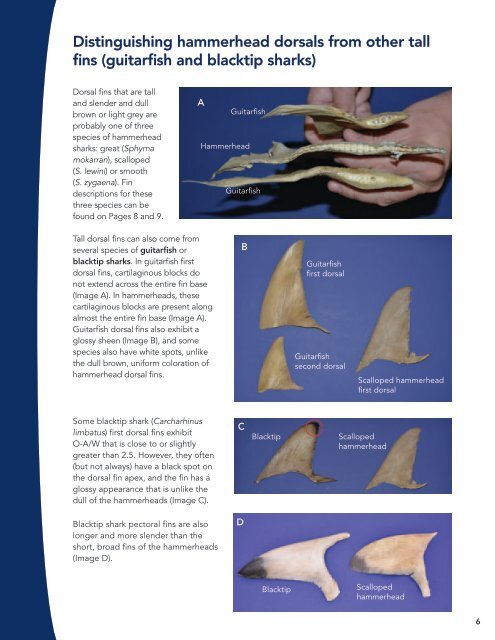Shark Fin ID Guide - Pew Environment Group
Shark Fin ID Guide - Pew Environment Group Shark Fin ID Guide - Pew Environment Group
Distinguishing hammerhead dorsals from other tall fins (guitarfish and blacktip sharks) Dorsal fins that are tall and slender and dull brown or light grey are probably one of three species of hammerhead sharks: great (Sphyrna mokarran), scalloped (S. lewini) or smooth (S. zygaena). Fin descriptions for these three species can be found on Pages 8 and 9. A Guitarfish Hammerhead Guitarfish Tall dorsal fins can also come from several species of guitarfish or blacktip sharks. In guitarfish first dorsal fins, cartilaginous blocks do not extend across the entire fin base (Image A). In hammerheads, these cartilaginous blocks are present along almost the entire fin base (Image A). Guitarfish dorsal fins also exhibit a glossy sheen (Image B), and some species also have white spots, unlike the dull brown, uniform coloration of hammerhead dorsal fins. B Guitarfish first dorsal Guitarfish second dorsal Scalloped hammerhead first dorsal Some blacktip shark (Carcharhinus limbatus) first dorsal fins exhibit O-A/W that is close to or slightly greater than 2.5. However, they often (but not always) have a black spot on the dorsal fin apex, and the fin has a glossy appearance that is unlike the dull of the hammerheads (Image C). C Blacktip Scalloped hammerhead Blacktip shark pectoral fins are also longer and more slender than the short, broad fins of the hammerheads (Image D). D Blacktip Scalloped hammerhead 6
Porbeagle Lamna nasus IUCN Red List Designation VULNERABLE 1st dorsal fin: dark blue/black to dark greyish brown, rounded apex with white patch on lower trailing edge onto free rear tip Courtesy of NOAA Fisheries Service Pectoral fins: short, rounded at apex; ventral surface has dusky coloration from apex throughout midsection of fin and along leading edge Dorsal view (top) Ventral view (underneath) ©IUCN IUCN Red List Designations: NE Atlantic and the Mediterranean subpopulations are Critically Endangered, and the NW Atlantic subpopulation is designated as Endangered Oceanic Whitetip Carcharhinus longimanus IUCN Red List Designation VULNERABLE 1st dorsal fin: large and broadly rounded (paddle-like); mottled white color at apex Pectoral fins: long, broadly rounded at apex; dorsal surface has mottled white color at apex; ventral surface is typically white but can have mottled brown coloration ➤ mottled white color also present on caudal fin (upper and lower lobe) ➤ very small juveniles may have mottled black coloration on dorsal, pectoral and caudal fins Courtesy of NOAA Fisheries Service ©IUCN Dorsal view (top) Ventral view (underneath) IUCN Red List Designations: NW Atlantic and Central Atlantic subpopulations are designated as Critically Endangered 7
- Page 1 and 2: Identifying Shark Fins: Oceanic Whi
- Page 3 and 4: The purpose of this guide Many expe
- Page 5 and 6: Step 2: Identify porbeagle and ocea
- Page 7: Distinguishing hammerhead dorsals f
- Page 11 and 12: Great Hammerhead Sphyrna mokarran I
Distinguishing hammerhead dorsals from other tall<br />
fins (guitarfish and blacktip sharks)<br />
Dorsal fins that are tall<br />
and slender and dull<br />
brown or light grey are<br />
probably one of three<br />
species of hammerhead<br />
sharks: great (Sphyrna<br />
mokarran), scalloped<br />
(S. lewini) or smooth<br />
(S. zygaena). <strong>Fin</strong><br />
descriptions for these<br />
three species can be<br />
found on Pages 8 and 9.<br />
A<br />
Guitarfish<br />
Hammerhead<br />
Guitarfish<br />
Tall dorsal fins can also come from<br />
several species of guitarfish or<br />
blacktip sharks. In guitarfish first<br />
dorsal fins, cartilaginous blocks do<br />
not extend across the entire fin base<br />
(Image A). In hammerheads, these<br />
cartilaginous blocks are present along<br />
almost the entire fin base (Image A).<br />
Guitarfish dorsal fins also exhibit a<br />
glossy sheen (Image B), and some<br />
species also have white spots, unlike<br />
the dull brown, uniform coloration of<br />
hammerhead dorsal fins.<br />
B<br />
Guitarfish<br />
first dorsal<br />
Guitarfish<br />
second dorsal<br />
Scalloped hammerhead<br />
first dorsal<br />
Some blacktip shark (Carcharhinus<br />
limbatus) first dorsal fins exhibit<br />
O-A/W that is close to or slightly<br />
greater than 2.5. However, they often<br />
(but not always) have a black spot on<br />
the dorsal fin apex, and the fin has a<br />
glossy appearance that is unlike the<br />
dull of the hammerheads (Image C).<br />
C<br />
Blacktip<br />
Scalloped<br />
hammerhead<br />
Blacktip shark pectoral fins are also<br />
longer and more slender than the<br />
short, broad fins of the hammerheads<br />
(Image D).<br />
D<br />
Blacktip<br />
Scalloped<br />
hammerhead<br />
6



